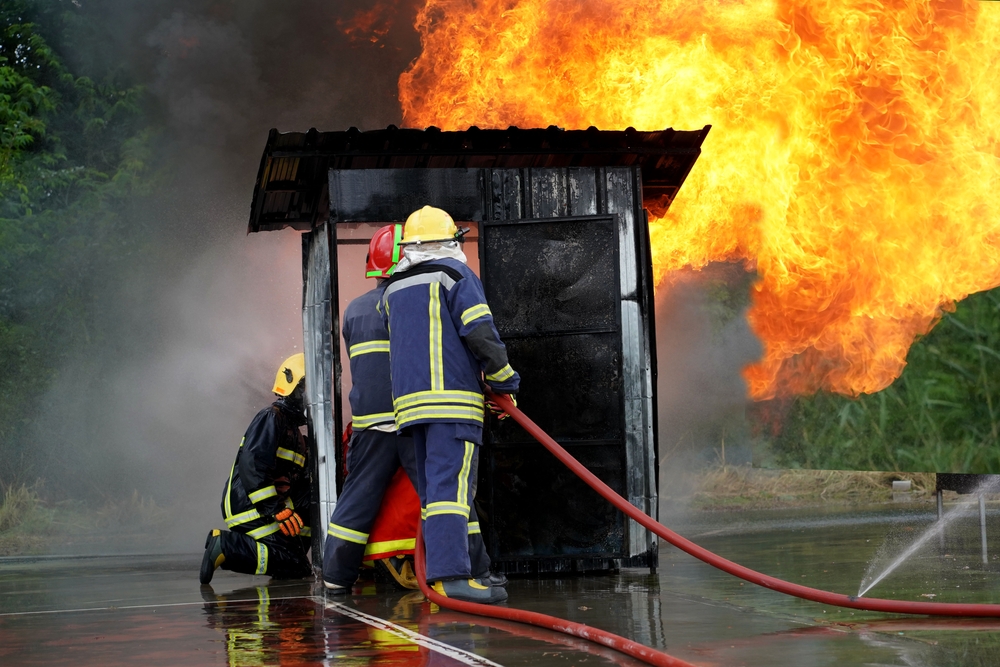Search
Explosion Prevention by Eliminating Sources of Ignition

Can you rely on control/ elimination of sources of ignition alone as a secure basis of safe operation? In this article we explore this question with the help of a look back to a rubber dust explosion that led to the death of 5 workers and injuries to 7 others.
When our Process safety consultants are evaluating fire and explosion hazards for our clients, we are always attempting to establish the basis on which each part of the process is considered to be safe; the ‘basis of safety’. Actually, this seemly daunting quest for a basis of safety does simplify down when you think about it. A process may be considered safe because:
- Potential flammable atmospheres are eliminated or controlled,
- Potential ignition sources are eliminated or controlled, or
- The plant has properly designed and maintained explosion protection and isolation measures in place.
In practice, a particular operation or process may have more than one of the above bases of safety in play, but it makes sense to identify ONE primary basis of safety upon which to ultimately rely. The question is, how much can we rely on elimination of ignition source as the only ‘basis of safety’?
The Explosion
Back in 2002, a rubber dust explosion occurred at a polymerics rubber recycling plant in Mississippi [Reference 1]. It resulted in the deaths of five workers and injuries to seven others. The rubber recycling process included a wet slurry operation, followed by gas-fired drying of fine rubber paste and had an associated dust handling plant with bag house and screw conveyor beneath.
An employee who was just leaving work in his vehicle noticed a fire in the rubber plant bag house located above the plant’s 30 ft roof.
It is believed that rubber dust which had previously been expelled from the plant’s dryer system’s exhaust stack had deposited on top of the bagging bin [Reference 2]. OSHA concluded that hot rubber entrained in the exhaust from the product dryer fell onto the building roof, and due to the negative pressure created inside the top of the bagging bin by the bag house blower-vacuum system, hot smoldering embers were sucked into the bagging bin causing a violent dust deflagration. Dust in the bagging bin, which was not equipped with explosion venting, ignited and exploded causing mechanical failure. A screw conveyer below the bagging bin received burning material and also suffered mechanical failure. Eventually, dust layers that had accumulated on surfaces were raised and ignited in secondary explosion. Once started, the explosion/ fire quickly spread through the plant.
ignition source = explosion hazard
We can immediately identify the first ignition source as hot rubber dust entrained in the dryer exhaust and depositing on the roof. In general, rubber dusts have been found to exhibit self-heating properties leading to fire, so even if the rubber dust leaving the dryer was not sufficiently hot to cause direct ignition, exothermic behavior of warm dust piles may increase the dust temperature. We see that the hot/ burning rubber was likely pulled into a bag house where dust concentrations were sufficiently high to support explosion. We also see evidence of transfer of burning material to the screw conveyor and workspace where other dusts could be raised and ignited in secondary explosion and fire spread.
The Mississippi dryer as described was not fitted with explosion protection (no explosion relief panels). So, by default it seems as though the assumed basis of safety was ‘avoidance of ignition sources’ – an assumption that proved to be unsound.
OK, so we could look to see why the dryer was emitting hot rubber dust in the first place and why the explosion was so severe; The OSHA investigation concluded that design and procedures for operating the gas-fired dryers and dust collector were inadequate on plant.
As consultants, we know that direct fired dryers, for example, should draw combustion air from a clean source, prevent dust from entering the combustion chamber, have well maintained burners and fuel/ air mixtures and more. But even with this we still have a dust collection system that is collecting a potentially thermally unstable powder which contains an explosible dust concentration and which does not have any explosion relief protection. What’s more, any explosion in the bag house could freely transmit pressure and burning material into the screw conveyor and then into plant workspaces.
Would you have identified this ignition source before the plant was built and been able to design plant with a basis of safety which is control of ignition source alone?
The General Case
Sources of Ignition for fire & explosions
The challenge with relying on elimination of ignition sources as the sole basis of safety is that there are many different potential ignition sources that can arise on plant and can initiate a fire, flash fire, or explosion. Identifying and eliminating them all is possible in some situations but can be rather difficult in others. Here is a list of some of the main ignition sources that can occur on process plant in general, all of which have led to fires or explosions over the years!
- Open flames
- Cutting and welding/ Hot work
- Use of cigarettes/matches
- Friction heating or sparks
- Hot surfaces
- Spontaneous combustion/self-heating
- Impact sparks
- Lightning strikes
- Sparks from electrical equipment
- Electrostatic discharges
- Stray currents
- Electromagnetic radiation of different wavelengths
The astute reader will immediately be thinking ‘Ah, on my plant we have procedures in place designed to control hot work (permits), sparks from electrical equipment (Hazardous Area Classification) and more’. We would be concerned, of course, if you did not have these things in place. But are you sure you have equipment that cannot get hot, that static sparks cannot arise, that equipment failure cannot lead to impact sparking and that any solid materials you process cannot self-heat…. and more?
Can you ever rely on control/ elimination of sources of ignition alone as a secure basis of safe operation?
So, we return to our opening question: Can you rely on control/ elimination of sources of ignition alone as a secure basis of safe operation?
Our considered answer to this question is YES, you can operate some processes safely where you have avoidance of ignition sources as the primary basis of safety… BUT…. only in certain situations where all ignition sources that could be present during normal and abnormal operating condition are identified and reliably managed. This requires proper knowledge of the maximum energy of the identified ignition sources and the ease of ignition of the powder accumulations/ dust clouds by those ignition sources.
A simple example of reliance on ignition source elimination as a primary basis of safey might be an operator transferring fine, combustible powder with a scoop from one container to another on a weigh scale, say. In that operation we will have a small local, combustible dust cloud and no formal explosion protection. We may have local dust control to reduce the scale of any dust ‘cloud’, but we are essentially relying on control of ignition source as our primary basis of safety. This does involve performing an assessment of all potential ignition sources to include static electricity and electrical equipment.
More complicated systems can operate a with similar ignition source control as basis of safety but the more complicated the system, the more work is required to identify and control ALL possible ignition sources.
Sometimes, of course, the effort and data needed to operate SOLELY with ‘ignition source control’ as the only basis of safety may be impractical. For many dust collectors, our view is that it is probably prudent to include some form of explosion protection – such as explosion relief vents – as the primary basis of safety. Afterall, many dust collectors will contain combustible dusts and that dust can ordinarily be dispersed inside, creating an explosible atmosphere during operation. How such protection is designed is critical and the subject for another Process Safety Dispatch, but it should be noted that the design should be such as to ensure the protection of people and plant in the event of its activation – and also to note that design depends on the explosion characteristic of the contained dusts as measured by the dust Kst value and maximum explosion pressure.
Control of ignition sources is of course ALWAYS important on plant! Even if you have another basis of safety (e.g., explosion relief and isolation) as your primary basis of safe operation, you do not want the protected vessel to explode on your plant, even if everything works as designed. So, ignition source control is important in that case; it’s just that you are not relying on it alone. It’s not your primary basis of safety!
References
Reference 1: US Chemical Safety Board Investigation Report Number 2006-H-1, 2006
Reference 2: OSHA Accident Report 201361813 – Report ID0419400 “Twelve Employees Injured In Bagging Bin Explosion”, Accident open date 5/16/02 –
Reference 3: UK Health and Safety Executive https://www.hse.gov.uk/rubber/spontaneous.htm

Get in touch
To learn more about our expertise and services in dust explosion prevention & mitigation, call us at +1 609 455 0001 or email us at [email protected] today.
We also offer tailored virtual and in-company process safety training programs on Dust Explosions, Static Electricity and HAC (Hazardous Area Classification) and more. Find further information here.










